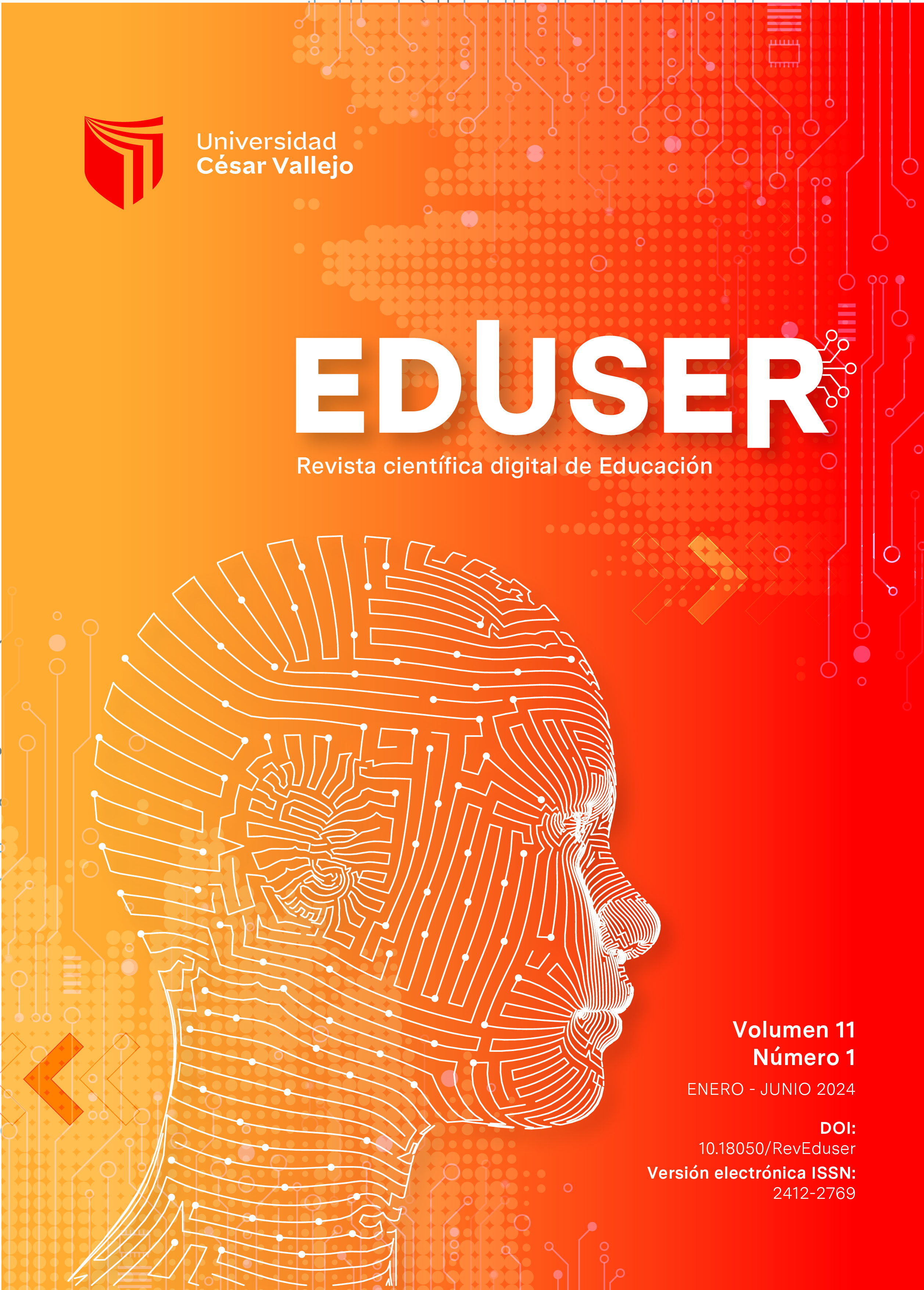Percepción y Aceptación del B-Learning en Matemáticas para Ingeniería por Estudiantes: Un Enfoque Basado en TAM
DOI:
https://doi.org/10.18050/eduser.v11n1a6Palabras clave:
b-learning, TAM, educación matemática, ingeniería, aceptación tecnológicaResumen
Este estudio explora la aceptación del b-learning en clases de matemáticas para estudiantes de ingeniería, utilizando el Modelo de Aceptación de la Tecnología (TAM) como marco teórico. Con una muestra de 153 estudiantes de una universidad tecnológica en México, se evaluaron constructos clave como la Utilidad Percibida (PU), la Facilidad de Uso Percibida (PEOU), la Influencia Social (SI), la Facilidad de Condiciones (FC), la Actitud hacia el Uso (AT) y la Intención de Uso (BI). Los resultados mostraron que el TAM es un predictor fiable de la aceptación del b-learning, con un índice de fiabilidad del instrumento de α = 0.9, lo que respalda su capacidad para identificar las variables que influyen en la adopción de esta modalidad educativa. El análisis reveló que la actitud hacia el b-learning es un determinante significativo de la intención de aprender matemáticas mediante este método, mientras que la influencia social, aunque relevante, no mostró una relación directa con la actitud hacia el aprendizaje. La facilidad de condiciones, incluyendo el acceso a internet y el apoyo docente, influyó positivamente en la percepción de utilidad y facilidad de uso del b-learning. Estos hallazgos subrayan la importancia de garantizar recursos tecnológicos adecuados y apoyo institucional para maximizar la eficacia del b-learning en la enseñanza de matemáticas. Se sugiere que futuras investigaciones exploren otras variables predictoras no consideradas en este estudio para un análisis más completo del TAM en contextos educativos.
Descargas
Referencias
Abreu, J., Wingartz, N. & Hardy, N., (2019). New Trends in Solar: A Comparative Study Assessing the Attitudes Towards the Adoption of Rooftop PV, Energy Policy, 128, 347-363 https://doi.org/10.1016/j.enpol.2018.12.038
Abubakar, R.R., Amirrudin, K. & Nor, A. A. (2020). Challenges in the online component of blended learning: A systematic review. Computers & Education, 144. 103701 https://doi.org/10.1016/j.compedu.2019.103701.
Ajzen, I. (2020). The theory of planned behavior: frequently asked questions. Human behavior and emerging technologies, 2. 314-324. https://doi.org/10.1002/hbe2.195
Apaza, M.D. E. (2022). Competencias digitales docentes y el proceso de enseñanza aprendizaje con modalidad B-learning. Horizontes Revista de Investigación en Ciencias de la Educación, 6(24), 894-905. https://doi.org/10.33996/revistahorizontes.v6i24.384.
Area, M.M., Bethencourt, A. A., Martín, G. S. (2020). Visiones del alumnado. Campus virtuales, 9(2), 35-50. https://dialnet.unirioja.es/servlet/articulo?codigo=8005979
Bandura, A. (1986). Social foundations of thought and action: A social cognitive theory. Prentice-Hall, Inc.
Celada, R. E., Romero, C. R. Márquez, U. P., Espíritu, M. P., Espinoza, V., Espinoza, E.M., Gómez, P. K.K., Valero, A.V.N., Gonzales, F. I.K. (2023). Estrategia B-learning para un desarrollo significativo: una revisión bibliométrica. Bibliotecas. Anales de Investigacion, 19(2), 1-15 https://dialnet.unirioja.es/servlet/articulo?codigo=9050371
Cerrón, R. W. (2019). La investigación cualitativa en educación. Horizonte de la Ciencia, 9(17), 1-8. https://doi.org/10.26490/uncp.horizonteciencia.2019.17.510
Davis, F. D. (1989). Perceived usefulness, perceived ease of use, and user acceptance of information technology. MIS Quarterly, 13(3), 319-340. https://doi.org/10.2307/249008
Feria, R. A. J., Guayara, R. M. A., Vera, C., S. L., Castro, R. K. E. y Muñoz, M. S. (2023). Análisis del sistema de aprendizaje LMS utilizado para la gestión de tareas escolares bajo la modalidad b-learning en la institución educativa técnica la Chamba del Guamo Tolima. Revista Pensamiento Transformacional, 2(4), 50-69. https://revistapensamientotransformacional.editorialpiensadiferente.com/index.php/pensamiento_transformacional/article/view/34
Fishbein, M. & Ajzen, I. (1975). Belief, attitude, intension and behavior: An introduction to theory and research. Addison Wesley
Fornell, C. y Bookstein, F. L. (1982). Two Structural Equation Models: LISREL and PLS Applied to Consumer Exit-Voice Theory. Journal of Marketing Research, 19(4), 440-452. https://doi.org/10.2307/3151718
García, A.L. (2021). COVID-19 y educación a distancia digital: preconfinamiento, confinamiento y posconfinamiento. RIED-Revista Iberoamericana De Educación a Distancia, 24(1), 09–32. https://doi.org/10.5944/ried.24.1.28080
Granic, F. & Marangunic, N. (2019). Technology acceptance model in educational context: A systematic literature review. British Journal of Educational Technology, 50 (5), 2572-2593 https://doi.org/10.1111/bjet.12864
Guy, A. (2020). Age and gender differences in online travel reviews and user-generated-content (UGC) adoption: extending the technology acceptance model (TAM) with credibility theory. Journal of Hospitality Marketing & Management, 29(4), 428-449. https://doi.org/10.1080/19368623.2019.1653807
Han, JH., Sa, H.J. (2022). Acceptance of and satisfaction with online educational classes through the technology acceptance model (TAM): the COVID-19 situation in Korea. Asia Pacific Educ. Rev. 23, 403–415 https://doi.org/10.1007/s12564-021-09716-7
Hernández, A.C.E., Carpio, N. (2019). Introducción a los tipos de muestreo. Alerta, 2(1), 75-79. https://doi.org/10.5377/alerta.v2i1.7535
Hernández, S. R., Fernández, C. C., & Baptista, L. P. (2019). Metodología de la investigación. Ciudad de México. McGraw-Hill.
Lagos, R. G., Cevallos, C. A., Espinosa, I, J., & Nivela, C. A. (2020). El B-learning y su aplicación en la enseñanza universitaria del Ecuador. Sinergias Educativas, 5(2), 222–234. https://doi.org/10.37954/se.v5i2.146
Lazim, C. S. L. M., Ismail, N. D. B., & Tazilah, M. D. A. K. (2021). Application of technology acceptance model (TAM) towards online learning during covid-19 pandemic: Accounting students perspective. Int. J. Bus. Econ. Law, 24(1), 13-20. https://www.ijbel.com/wp-content/uploads/2021/02/IJBEL24_507.pdf
Liao, S., Jon-Chao, H., Yi-Chen P., Ming-Hui, W., & Yun-Wu, W. (2018). Applying Technology Acceptance Model (TAM) to explore Users’ Behavioral Intention to Adopt a Performance Assessment System for E-book Production. EURASIA, 14(10). https://doi.org/10.29333/ejmste/93575
López, R. L.J, Jiménez, G. A.L., Costilla, L.D. (2022). The Effects of Blended Learning on the Performance of Engineering Students in Mathematical Modeling. Education Sciences, 12(12):931. https://doi.org/10.3390/educsci12120931
López, B. J., Pozo, S., y Moreno, G. A. J. (2019). Consideraciones sobre el b-learning en el proceso de enseñanza y aprendizaje. Universidad & Ciencia, 8(2), 24–39. https://revistas.unica.cu/index.php/uciencia/article/view/1239
Malatji, W.R., Eck, R.V., & Zuva, T. (2020). Understanding the usage, Modifications, Limitations and Criticisms of Technology Acceptance Model (TAM). Advances in Science, Technology and Engineering Systems Journal, 5, 113-117. https://www.astesj.com/v05/i06/p12/
Marín, V.L.M., Vinuesa, L.M., & Rojas, G. P. (2023). E-Learning Web-Apps Use Acceptance: A Way to Guide Perceived Learning Outcomes in Blended Learning. Sustainability, 15(3), 2136. https://doi.org/10.3390/su15032136
Martín, G. A. V., Redolat, R., & Pinazo-Hernandis, S. (2022). Factors influencing intention to technological use in older adults. The TAM model application. Research on Aging, 44(7-8), 573-588. https://doi.org/10.1177/01640275211063797
Mateo, J. (2004). La investigación expost-facto. En R. Bisquerra (Ed.), Metodología de la investigación educativa (pp.195-230). La Muralla.
Maturrano, L.E. F. (2020). La investigación cualitativa en Ciencias Humanas y Educación. Criterios para elaborar artículos científicos. EDUCARE ET COMUNICARE Revista De investigación De La Facultad De Humanidades, 8(2), 56-66. https://doi.org/10.35383/educare.v8i2.536
Nadlifatin, R., Miraja, B., Persada, S., Belgiawan, P., Redi, A.A.N. & Lin, S.C. (2020). The Measurement of University Students’ Intention to Use Blended Learning System through Technology Acceptance Model (TAM) and Theory of Planned Behavior (TPB) at Developed and Developing Regions: Lessons Learned from Taiwan and Indonesia. International Journal of Emerging Technologies in Learning (iJET), 15(9), 219-230. Kassel, Germany: International Journal of Emerging Technology in Learning. https://www.learntechlib.org/p/217222/.
Núñez-Barriopedro, E., Monclúz, I. M., & Ravina-Ripoll, R. (2019). El impacto de la utilización de la modalidad B-Learning en la educación superior. Alteridad. Revista de Educación, 14(1), 26-39. https://doi.org/10.17163.alt.v14n1.2019.02
O´Dwyer, L. & Bernauer, J. (2014). Quantitative research for the qualitative researcher. Sage
Rad, D., Egerau, A., Roman, A., Dughi, T., Balas, E., Maier, R., Ignat, S., & Rad, G. (2022). A Preliminary Investigation of the Technology Acceptance Model (TAM) in Early Childhood Education and Care. BRAIN. Broad Research in Artificial Intelligence and Neuroscience, 13(1), 518-533. https://doi.org/10.18662/brain/13.1/297
Romero, S. (2018). Entornos flexibles para el aprendizaje: B-Learning. International Technology, Science and Society Review 7(1), 9–15. https://doi.org/10.37467/gka-revtechno.v7.317
Rosli, M. S., Saleh, N. S., Md. Ali, A., Abu Bakar, S., & Mohd Tahir, L. (2022). A Systematic review of the Technology Acceptance Model for the sustainability of higher education during the COVID-19. Pandemic and Identified Research Gaps. Sustainability, 14(18), 11389. http://dx.doi.org/10.3390/su141811389
Sánchez, R. L. M., Moll, L.S., Nuñez, P. A., Moraño, F. J. A, Vega, F. E. (2023). ChatGPT challenges blended learning methodologies in engineering education: A case study in mathematics. Applied Science, 13(10), 6039. https://doi.org/10.3390/app13106039
Suárez, C.A.H., Castro, W.R.A., Suárez, A.A.G., (2022). Impact Of B-Learning supported by the flipped classroom: An experience in higher education. Journal of Language and Linguistic Studies, 18(3), 119-129. https://www.jlls.org/index.php/jlls/article/view/4790
Suárez, E. R., Cavazos, S. R. L., Rojas, M. I., y Arturo-Castillo, J. (2023). Percepciones de los estudiantes sobre la aceptación de dos plataformas digitales durante la pandemia: un análisis utilizando el modelo de aceptación de tecnología. Revista Ciencia UANL, 24(109), 38–41. http://cienciauanl.uanl.mx/?p=11239
Terán, G. F. N. (2019). Aceptación de los estudiantes universitarios en el uso de los sistemas e-learning Moodle desde la perspectiva del modelo TAM. CIENCIA UNEMI, 12(29), 63-76. https://doi.org/10.29076/issn.2528-7737vol12iss29.2019pp63-76p
Venkatesh, V. & Davis, F. D. (2000). A theoretical extension of the technology acceptance model: Four longitudinal field studies. Management Science, 46(2), 186-204. https://doi.org/10.1287/mnsc.46.2.186.11926
Zhang, M., Qin, F., Wang, G. A., & Luo, C. (2020). The impact of live video streaming on online purchase intention. The Service Industries Journal, 40(9-10), 656-681. https://doi.org/10.1080/02642069.2019.1576642
Archivos adicionales
Publicado
Número
Sección
Licencia
Derechos de autor 2024 Elia Trejo, Natalia Trejo Trejo

Esta obra está bajo una licencia internacional Creative Commons Atribución 4.0.














